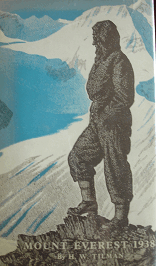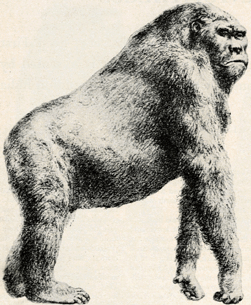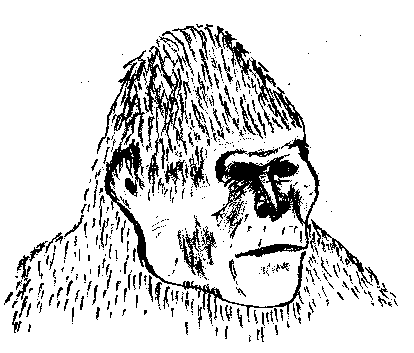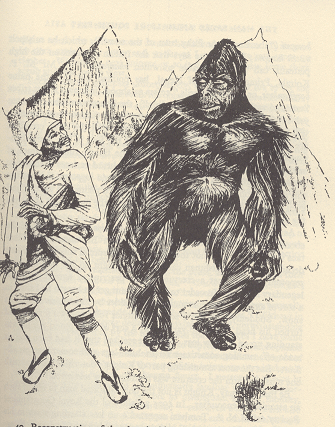|
Meet the Yeti |
|||
|
The “Yeti” is the first “wild man” to ever gain international fame. This is ironic, for his habitat is in the incredibly remote and inaccessible Himalayas. The Brits were the first, naturally, to hear about him, since they controlled India in the 19th century and frequently traveled north into the mountain kingdoms of Nepal and Bhutan on the shoulders of the Himalayas. Always interested in big game, British sportsmen continued to pay special attention to the stories. Then in 1921, attempting to tackle Mount Everest, Colonel Charles Howard-Bury came upon strange human-like tracks of a biped at 22,000 feet. His Sherpa guides declared “Metoh Kangmi!” Kangmi was easy to translate— Kang = Snow; mi = man. Metoh is close to disgusting or filthy. Thus it was a filthy snowman. After the expedition returned, Howard-Bury sent wires from Darjeeling mentioning the Metoh Kangmi. Metoh had been transcribed incorrectly to Metch and this was ambiguous. An English teacher, Henry Newman, was asked to translate it. He said it meant “Abominable.” The “Abominable Snowman” as a concept was born and it delighted the British public. The legend grew from there until the Abominable Snowman became something akin to a music comedy hall manbeast running around the Himalayas giving everyone a right scare. When serious, Britons debated whether it was a bear WWII dashed the luxury of pursuing legend. H.W. Tilman had devoted an appendix to the Abominable Snowman in his account of his 1938 Everest Expedition. Unfortunately, the war delayed its publication for 10 years. In 1948 it finally came out. Though Tilman devoted only an appendix to the “Abominable Snowman,” a war torn Britain’s interest was revitalized and there was much interest in the Yeti again. Before the war Britons had been willing to accept that the reality behind the Abominable Snowman was a bear. This was based on Ronald Kaulback’s sensational debunking of the enigma in 1937. When his expedition had come across footprints, his Sherpas had declared “yeti.” However, the prints were quite clearly those of a bear. But Tilman’s epilogue was much more preferred. He ended his appendix with a gallant acknowledgment that until some animal could be proved to be the Abominable Snowman it is best to defer to the legend. Only a few years later, in 1951, all the theorizing changed. Eric Shipton and Dr. Michael Ward were on the Menlung La preparing for the 5th Everest Expedition. They came across a track line in the snow. It was of a biped. They found a print as clear as if made in wax. Shipton’s Sherpa said: “Yeti.” Shipton took a photo. One of the Shipton photos. This has his pick ax next to it for comparison. He took another with the boot of his partner Dr. Michael Ward next to it in order to help gauge the size of the print. It is about 13 inches long. The print was made by something that wasn’t human and it wasn’t a bear. Nor was it an ape. But it looked like a cross between a human and an ape. It wasn’t long before someone said “ape man.” No one had imagined this before. It was really not part of the legend. Britain (and soon the world) was enthralled by the prospects. Thus the Yeti became the same thing as the Abominable Snowman, and in a flurry of debate throughout the 1950s the Yeti became a subhuman ape man— a missing link still surviving in the remote Himalayas. The whole idea was dynamite. Some of the most erudite men of their time took it seriously. Vladimir Tchernesky proposed the theory that Yeti was a living Gigantopithecus, a prehistoric giant ape that many anthropologists believed had been bipedal. Dr. Bernard Heuvelmans, the “Father of Crypto-zoology,” agreed. Ivan Sanderson, a popular science personality, also endorsed this, and so did Harvard’s Carlton Coon. This was the crux of it. No one wanted a “subhuman” missing link. They wanted an “ape man” type of missing link, something far more ape than human; basically just a bipedal hominid. This is far more spectacular than something very human. A strange human could just turn out to be an extreme variation of a human being. But a bipedal ape was an obvious example of an undeniable stage of evolution-- not human and not just some dumb waddling ape from Africa. British naturalist Earl Nelson laboriously clarified in the Evening News that the Yeti will not prove to be a man, sub-man or even ape-man. Rather, the Yeti could prove to be a lateral descent from a common simian ancestor. Nelson declared sensationally: “It is now clear from the fossil record that at various time periods in the remote past a great many different species of men were evolved, just as happened in the case of other mammals, notably the horse and elephant.” He further declared: “It is possible that the Yeti may prove to be an ape of a type closer to ourselves than any other existing species. [Its] description could well apply to the probable appearance of extinct Neanderthal man or to the ape-man of Africa. The Yeti could be a survivor that has lingered on long after other creatures of this type have become extinct. One wonders what he can find to live on among the snows of the Himalayas. He is said to have killed and eaten men, but this is not surprising. Our remote ancestors were cannibals just as some of our human contemporaries are.” The idea of a missing link, at any stage of development, was becoming so garish that the much-publicized 1954 Daily Mail Expedition tried to quash the theories. The leaders of that expedition, journalist Ralph Izzard and biologist Charles Stonor, went out of their way to debunk the idea of a subhuman. They believed Yeti to be an interesting and undiscovered Animal X or Anthropoid X. They accentuated that Sherpa descriptions always mentioned a tall cone head on the beast, which is not even remotely an indication of a subhuman. They also accentuated that the Yeti was only the size of a 14 year old boy and when in a hurry, as in chasing cattle, it would go down on all fours. This really didn’t smack of “missing link,” did it? The theory of Gigantopithecus offered an interesting compromise, one mutely also contained in Nelson’s theorizing. Fossils had been discovered in the nearby Silawak Hills north of India. A jawbone belonged to an ape, but it was huge. Other bones seemed to indicate something more manlike. Far away in a Chinese curio shop, Ralph von Koenigswald found giant molars. They were also human-like but huge. Put together, it seemed as though a giant, perhaps bipedal ape with far more human-like teeth, had once existed. For the evolutionary theories of the time this made Gigantopithecus a missing link and not just an undiscovered species of giant ape. No one believed mankind descended from giant anthropoids, so this meant it was some lateral example of evolution, just as Nelson had hoped for. It didn’t matter that it wasn’t considered on the human pathway, it was thought to have been bipedal and that meant it was a telltale sign of evolution. It was not a missing link with mankind, but it was an indication of the theory that missing links had existed. Gigantopitchecus, a hypothetical reconstruction. Nevertheless, the West became so “subhuman” consumed that no one really bothered to pay attention to sober research. On one hand there were attempts to debunk the whole thing, and on the other hand make an officially undiscovered anthropoid proof of man’s evolution. On the debunking end of the spectrum, it was noted that the Sherpas call most anything “yeti.” So they did. All yeh-teh means is “thing” or “entity” of the rocks. Most anything that dwelt on the rocky slopes of the Himalayas was called a yeh-teh at one point or another. When speaking of specific things, however, the Sherpas get detailed. Those who believed in the “ape man” Yeti noted that the Sherpas speak of a manlike thing of the rocks they call mih-teh. Roughly translated this means “man thing.” Charles Stonor had even made it very plain in his book The Sherpa and the Snowman that when Sherpas spoke of the Yeti, for all intents and purposes, they meant the mih-teh. It was the mih-teh yeh-teh— the “man thing rock dweller.” This becomes significant, for it seems Metoh Kangmi and Mi-teh Yeti are also not the same thing. Ronald Kaulback, the English explorer, was the first to note that there also existed in this area of the Himalayas the Mirka. They were wild, primitive men who have hair on their backs and they wear animal skins. This description, once again, almost sounds like it came from a Rice Burroughs novelette account of cavemen. Yet as we saw in “Meet the New Sasquatch” such a people as the Mulen and Chuchuna were known to live north of here in Yakut and Siberia, and from independent witness accounts they sound remarkably similar to the “Sasqautch” people of British Columbia. Amazingly, the Abominable Snowman appears to have been just that, a branch of those strange people P.L. Dravert spoke about in his book Mulen and Chuchuna Peoples. Charles Stonor had admitted they had come across barefoot human looking tracks, but since they didn’t fit the mosaic of the legend, the 1954 Daily Mail Expedition didn’t know what to think of them. Everybody thought in terms of only “Yeti” and that it was both the Abominable Snowman and everything else contained in the legend. It was a cone-headed ape-like anthropoid. Nothing more. There was nothing else.
A popularized early image of the Yeti-- manlike face with tall cone head. It was a compromise between the Animal X theory of Izzard and Stonor and those who wanted to believe in a “missing link.”
A clear description of the type of people the Sherpas described, and which apparently only we in the West confused to be the Mih-teh Yeti, comes from Dagestan. This is the land of none other than Zana, the strange hairy woman who seems to be the last pure representative of a Sub Saharan people we cannot explain and who have features similar to European Neanderthals. In 1941, Colonel Dr. V.S. Karapetyan was called upon to examine a strange man captured by Soviet troops. His report was preserved by the Soviet Snowman Commission under Dr. Boris Porshnev. It reads: I entered a shed with two members of the local authorities. When I asked why I had to examine the man in a cold shed and not in the warm room, I was told that the prisoner could not be kept in a warm room. He had sweated in the house so profusely that they had had to keep him in the shed. I can still see the creature as it stood before me, a male, naked and barefooted. And it was doubtlessly a man, because its entire shape was human. The chest, back, and shoulders, however, were covered with shaggy hair of a dark brown color. This fur of his chest was much like that of a bear, and 2 to 3 centimeters long. The fur was thinner and softer below the chest. His wrist was crude and sparsely covered with hair. The palms of his hands and soles of his feet were free of hair. But the hair on his head reached to his shoulders partly covering his forehead. The hair on his head, moreover, felt very rough to the hand. He had no beard or mustache, though his face was completely covered with a light growth of hair. The hair around his mouth was also short and sparse. The man stood absolutely straight with his arms hanging, and his height was above the average— about 6 feet. He stood before me like a giant, his mighty chest thrust forward. His fingers were thick, strong, and exceptionally large. On the whole, he was considerably bigger than any of the local inhabitants. His eyes told me nothing. They were dull and empty— the eyes of an animal. And he seemed to me like an animal and nothing more. As I learned, he had accepted no food or drink since he was caught. He had asked for nothing and said nothing. When kept in a warm room he sweated profusely. While I was there, some water and then some food was brought up to his mouth; and someone offered him a hand, but there was no reaction. I gave the verbal conclusion that this was no disguised person, but a wild man of some kind. Then I returned to my unit and never heard of him again. For many reasons, the stories of a strange human and those of an undiscovered anthropoid were conflated. Together they created a single species-- Yeti. On top of this, many wanted to believe that Yeti was 7 feet tall. This gave us a giant cone headed Gigantopithecus. Nevertheless, the Russians had a very different take on it all. Giantism, that mistake of Canadian Whites, did not creep into their studies. Thus the “Snowman” of Eurasia appears all the more believable. He was about 6 foot tall but twice the thickness of an ordinary man, just as the Salish Indians had describe one of the Sasquatch tribes. In Russia this had led to more serious scientific research. In remote places, members of the Snowman Commission even found Neanderthal-like footprints. No such footprint has been found in America. Rather I have had to resurrect the lost stories of a primitive tribe of caveman-like people. I did not have footprints. I had the long history of Indian artwork admirably reflecting the facial details which Eurasians also report. Along with this, there are many corroborating and independent stories over American and Eurasia. (See Recasting Bigfoot) Why had all this knowledge been lost in America? The short answer is that America became consumed with the idea of a giant cone-headed Yeti. Nothing more. In an unlikely location far from the Saskahaua of British Columbia this eventually took form as the BIGFOOT. It is time to meet BIGFOOT
|
|||
|
Q Files is not spontaneous extemporanea. |
||||||||||||
|
|
||||||||||||
 As early as 1832, reference to a “wild man of the snows” had appeared in print. Sherpas had called the creature a demon. The first author, B.H. Hodson, thought it was all “stuff and nonsense.” From their descriptions, he believed the Sherpas spoke of an orangutan. By 1880 another Englishman, Colonel Waddell, had heard of something called a Yeti. He is the first to undertake an active investigation. He believed the Sherpas were referring to a yellow bear.
As early as 1832, reference to a “wild man of the snows” had appeared in print. Sherpas had called the creature a demon. The first author, B.H. Hodson, thought it was all “stuff and nonsense.” From their descriptions, he believed the Sherpas spoke of an orangutan. By 1880 another Englishman, Colonel Waddell, had heard of something called a Yeti. He is the first to undertake an active investigation. He believed the Sherpas were referring to a yellow bear.  or some “filthy” mystic on the outs with society.
or some “filthy” mystic on the outs with society. 


